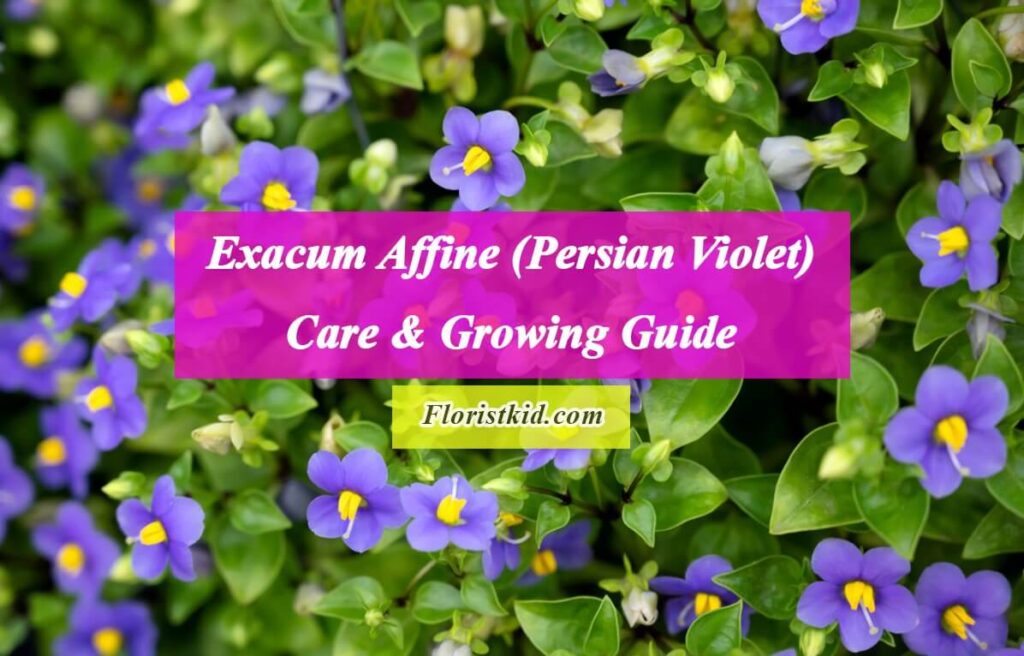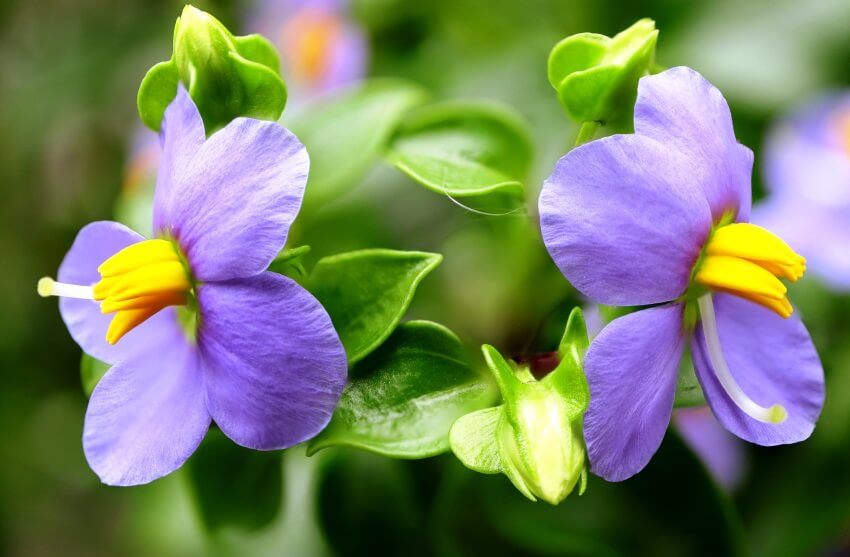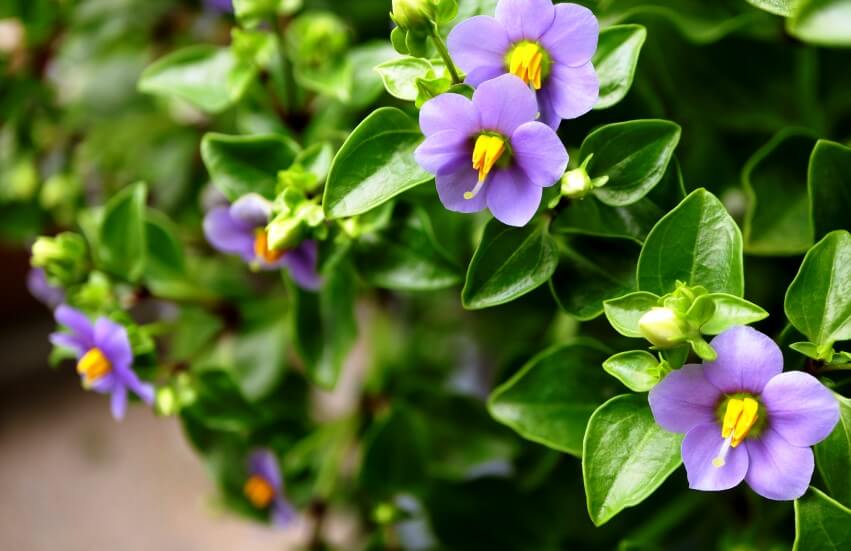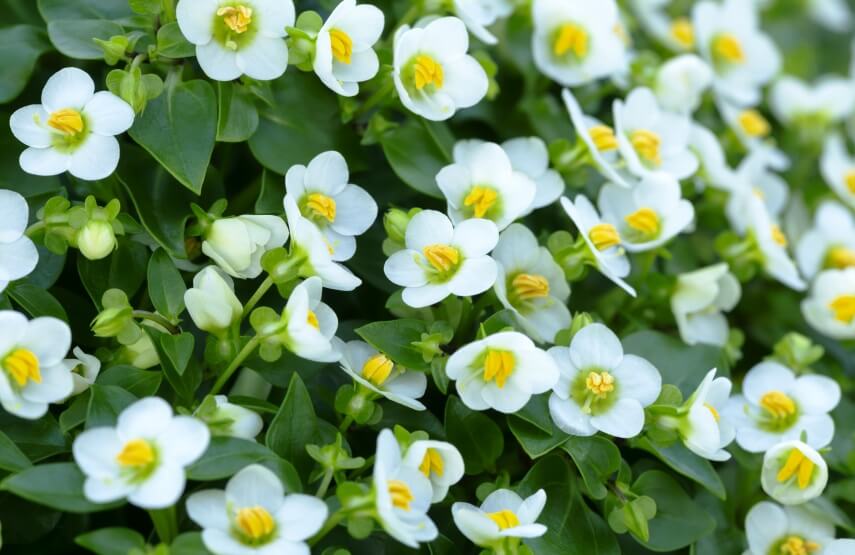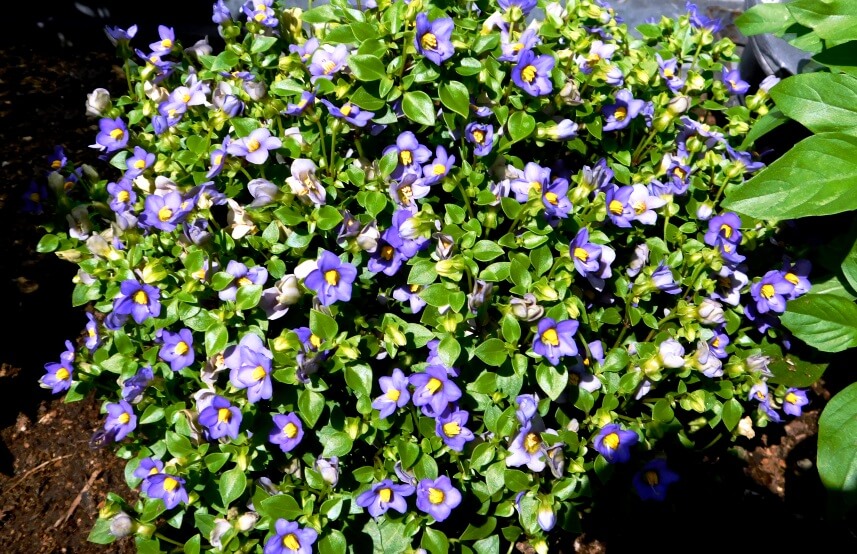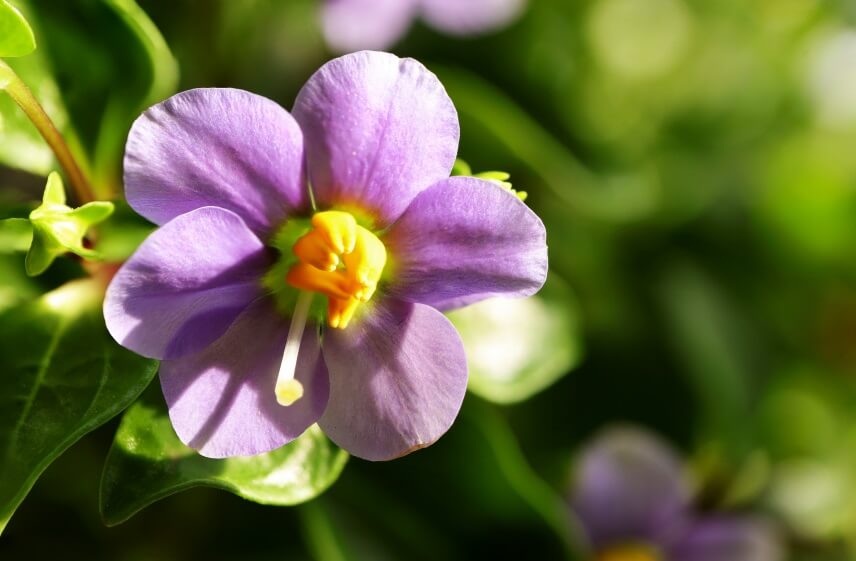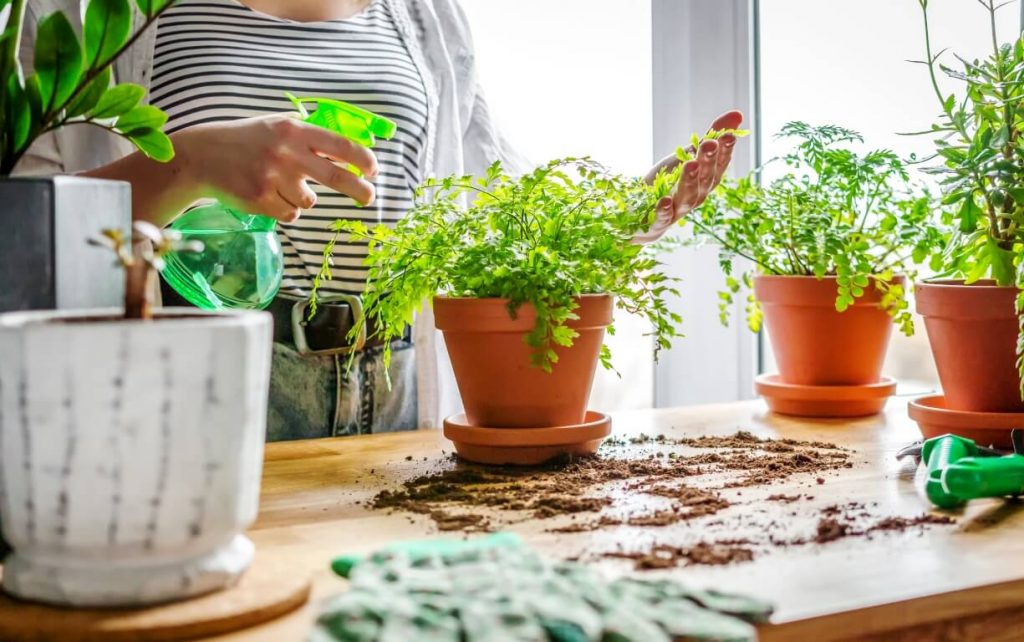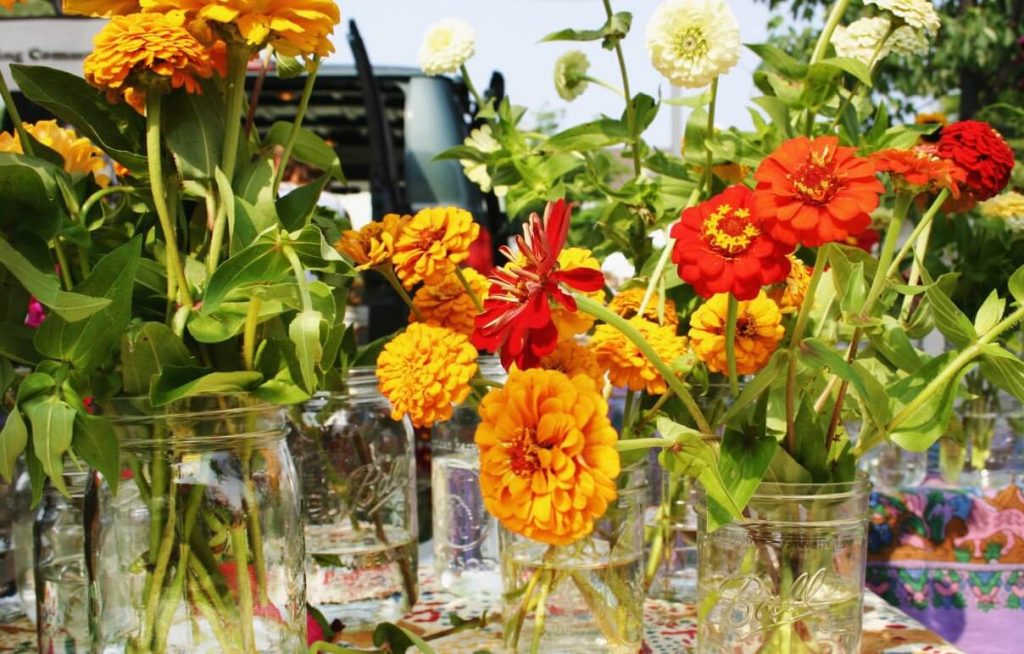Exacum affine is a delightful and fragile flowering plant which is a member of the Gentianaceae family. Despite being commonly referred to as the Persian Violet, this plant is originally native to Yemen. It flourishes in warm and humid tropical climates. Thanks to its attractive appearance and ease of cultivation, it has gained popularity as an indoor plant worldwide. In its natural habitat, this plant thrives in rocky areas. It can be identified by its dark green, ovate leaves and petite purple flowers featuring a fragrant, yellowish center [1].
Exacum Affine has captivated plant enthusiasts worldwide with its stunning blooms and unique characteristics. Due to its popularity, this article will dive into Exacum Affine’s growing guide and characteristics.
If you are interested in this topic, you can also read
<<Vriesea Splendens Care >> and <<LiliumLongiflorum Care>> articles.
Exacum Affine (Persian Violet) Overview
| Family | Gentianaceae |
| Origin | Arabian Peninsula (Yemen), Madagascar |
| Names | Persian violet, Clustered Persian violet, Blue Persian violet, Clustering Persian violet, German violet, Tiddly-Winks, Arabian Violet, Socotra violet |
| More species from the Gentianaceae family | Centaurium erythraea, Eustoma grandiflorum |
| Dimensions | Height: 6 to 18 inches / Spread:6 to 12 inches' |
| Toxicity | Slightly toxic |
| Life cycle | Annual or a short-lived perennial |
| USDA Hardiness Zones | 10-12 |
| Bloom time | Spring and summer |
| Foliage | Evergreen |
| Propagation method | Seeds, Cutting stems or leaf, division |
| Soil | Moist, well-drained, acidic |
| Flower colors | Blue and white |
About Exacum Affine (Persian Violet)
Exacum Affine, or Persian Violet, is fairly small but still attractive because of 1 to 5 inches long with ovate, petite, glossy dark leaves and fragrant, star-shaped, blue-violet flowers with yellow centers. Due to its vibrant flowers and sweet nectar, Exacum affine is a magnet for butterflies and bees. By adding this plant to your garden, you can enhance the garden’s beauty and provide a valuable food source for these important pollinators.
Persian Violet is a short-lived plant that only lasts two growing seasons. Although they are mostly considered indoor plants, they can also grow in tropical and subtropical regions. If planted outdoors, the planter will treat them as annual plants and remove them after they bloom. However, if they grow under the optimum conditions, they will re-bloom as a thank you!
Persian Violet Care
Planting Persian Violet in your garden and indoors is possible, but remember that transplanting might stress your Persian Violet, so do not change its place after planting. When growing in a pot, you must make sure that enough drainage holes exist.
Light
This tiny and beautiful flower prefers indirect light to grow well. Direct sunlight is more than enough for these plants and might scorch their foliage, so if you keep one at home, put them in a well-lit spot near a window or under grow lights.
Soil
As mentioned earlier, Persian Violet prefers rocky soil, which means they can stand various soil types as long as they are provided with enough drainage. A slightly acidic soil and African violet potting mix is ideal.
Watering
Keeping Exacum affine properly hydrated is essential for its well-being. It prefers consistently moist soil but not overly saturated. Allow the soil to dry moderately between the waterings and water them with room-temperature water since cold water can shock them. Enough watering and removing spent blooms will encourage your Persian Violet to bloom.
Watering this nice plant is kind of tricky. On the one hand, overwatering will result in wilting leaves. On the other hand, they will readily die if kept thirsty. It’s better to water it once per week in the cold season and increase it to two or three times a week during warmer seasons. If you notice wilting leaves while the soil is moist, you probably overwatered your plant, and you need to start with another one because root rot is not recovered in Persian Violet [2].
White persian violet
Blooming Time
If you want your Persian Violet to bloom in summer, you have to plant the seed mid-winter, and if you want to see the blooms in spring, you have to sow the seeds in autumn [3].
Sometimes, plants are in shock when you bring them home as they are adjusting to new light and humidity levels. So, take care of them with the tips mentioned in this article, and they will be recovered soon.
Temperature And Humidity
The ideal temperature for Persian Violet is between 60 – 75 Fahrenheit (16 – 24 centigrade). However, they can tolerate higher temperatures if moisture and shade are provided. Cold temperatures can kill them. If you keep them indoors, try to keep them away from air dryers, air conditioners, or other temperature-changing devices.
Persian Violet would be the happiest with 50% humidity, so a humidifier can benefit your plant, but never put your pot in water as it would lead to root rot. Instead, raise the humidity around it by placing the pot on a tray of wet pebbles.
Fertilizer
Use the usual liquid fertilizer to help your Persian Violet grow and bloom, but do not use a slow-released form of fertilizer since such fertilizer compounds might release too slowly to feed your lovely plant. Liquid fertilizer can be given monthly from spring to fall [4].
Common Pest And Disease Issues
Persian Violets are typically hardy plants that don’t commonly encounter serious issues with pests or diseases. However, it’s essential to remain vigilant, especially during dry seasons, for the presence of spider mites. If left unattended, these pests can extract plant juices from the leaves, causing them to lose their vibrancy and develop yellow speckles. Spider mites are particularly drawn to arid conditions, making them more likely to target houseplants during winter when indoor air lacks humidity.
These tiny creatures are often challenging to spot early on, and you may notice their presence through fine webbing around the plant’s leaves. Therefore, it’s crucial to regularly inspect the leaves and other parts of the Persian Violet plants for any signs of damage.
If you suspect that your Persian Violet is infested with spider mites, take action by removing affected yellow leaves. In addition, increase the watering frequency to elevate the moisture levels in the soil and the plant’s immediate environment. This will create less favorable conditions for the spider mites and help mitigate their impact.
Propagating Persian Violet
Persian Violets are typically planted using nursery plants in the spring after the risk of frost has subsided. If you have a desire to grow your collection of these lovely plants or want to share them with friends and family, you can effortlessly propagate Exacum affine plants through stem cuttings. Here’s a simple guide:
- Select a healthy stem from your existing Persian Violet plant.
- Remove the lower leaves from the stem, leaving a few leaves at the top.
- Place the prepared stem in a moist rooting medium, such as potting soil or a mix of perlite and peat moss.
- Ensure the cutting is planted at an appropriate depth and firm the soil gently around it.
- Provide a suitable environment with indirect light and consistent moisture.
After a few weeks, you should notice the development of roots from the cutting. At this point, you can pot the new plant into its own container, and it will grow into a beautiful Persian Violet. This propagation method is an excellent way to expand your collection or share the plant’s beauty with others [5].
Since Persian Violets are annual plants, you typically will not need to repot them, but in case they are root-bound, just gently move them to a bigger pot with the same depth, fresh soil, and enough draining. After repotting, moisten the soil by watering. Never repot a plant in bloom, which will also cause buds to drop [6].

